
Not too long ago, people would consult their Blackberry to keep in touch with the office… buy Kodak cameras and film to capture their memories… browse the shelves at Borders for interesting reads. Today these household names, and many others, are either defunct or shadows of their former selves. But competitors such as Apple and Amazon have skyrocketed to success. Why?
“Markets move faster than organizations,” observes Harbir Singh, the Mack Institute’s co-director and Wharton’s Vice Dean for Global Initiatives. And it’s impossible for any single firm to have a monopoly on innovation. So in order to survive and stay ahead of the game, companies must forge connections with other firms: investments, partnerships, alliances, acquisitions, and ecosystems.
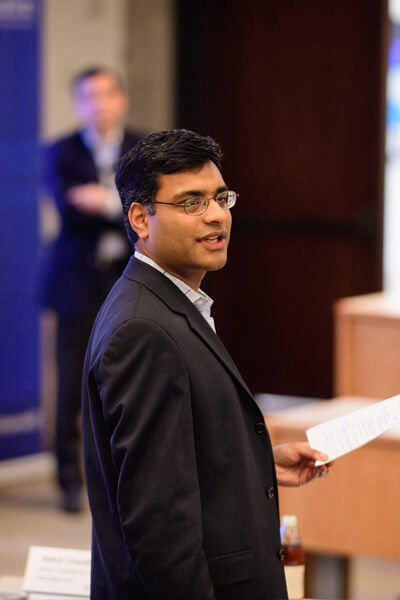
For example, Blackberry’s parent company RIM “tried to do a lot of things itself” and ended up entering the app development cycle very late, according to Saikat Chaudhuri, executive director of the Mack Institute and a Wharton management professor. On the other hand, Apple, “even though we like to think of them as being an engineering company — which they are — they’re an integrator of sorts.” Android, too, works with a number of suppliers. “It’s not just about single firms. It’s ecosystems,” says Chaudhuri.
But connecting with other firms is risky. Success rates hover at only around 40%. Which strategies are best to pursue, when, and with whom? How can companies expand their capabilities to better the odds?
These issues were explored at the Mack Institute Spring Conference 2017 in San Francisco, “Leveraging Ecosystems, Investments, and Acquisitions to Keep an Innovative Edge.” Here, top business and academic leaders came together to share learnings and best practices on partnering for success.
To Incubate, Partner, or Acquire?
In Chaudhuri’s introductory talk he noted, “Established firms have many strengths, but often struggle to sustain their innovative edge over time.” He named several mega-enterprises which face that challenge today, including Microsoft, Facebook, Intel, General Motors, Google, Cisco, Pfizer, ExxonMobil, and Yahoo.
“[For example,] the Exxon Mobiles are thinking about all these alternative energy sources,” he said. “And even Google is no longer the startup that it once was. That’s why for instance it had to buy — quote unquote ‘had to buy’ — YouTube. Its old offering didn’t quite work.”
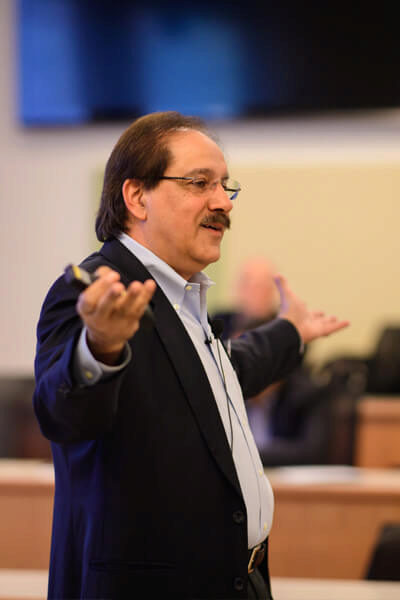
Many companies feel skittish about partnership strategies and instead opt for internal innovation, or in-house R&D. Singh said they do this because it gives them a sense of ownership and control, the cost is lower, and there are fewer cultural differences. But how successful are in-house strategies? According to research, only 15%. So external strategies offer much greater rewards. However, he emphasized, a portfolio approach to partnership is essential to mitigate risks, and this portfolio can include in-house R&D as well.
Singh said choosing the right way to partner based on the situation is critical. In the case of Disney and Pixar, he said, the alliance was unsuccessful, but the acquisition that followed was highly successful. With the alliance, “Pixar did not really want to share anything with Disney… [The company] was actually holding back a lot of knowledge.” For a very high degree of sharing and synergy, an acquisition is better, said Singh. The acquisition gave Disney a single chain of command and the ability to infuse more films with brilliant animation.
An alliance arrangement, though, worked outstandingly in the case of the Boeing 787 Dreamliner aircraft. First flown in 2009, “the 787 was the most outsourced airplane in the world and also the most innovative,” said Singh. Companies involved included Mitsubishi, GE, Rolls Royce, an Italian defense contractor, and firms in India and China. Singh said the 787 is distinguished by larger windows enabled by a strong composite fiber used in construction. This material also allows for higher cabin pressure, which enhances passenger comfort. Singh said that Airbus is now trying to replicate Boeing’s Dreamliner and finding that they, too, need to build a network of alliances.
Singh identified four factors for successful alliances: building partner-specific assets, accessing complementary capabilities, developing effective knowledge-sharing routines, and having appropriate governance structures. With these, a firm’s success rate for alliances can jump from 40 percent to about 60 percent.
Smart Strategies for Emerging Technology
In the session “Smart Emerging Technology Strategy,” Ankur Jindal, the Vice President and Head Corporate Venturing at Tata Communications, shared insights into how his company is moving into the future. Tata Communications’ parent company is the Indian multinational Tata Group, which boasts a market cap of about $116 billion and over 100 operating companies.
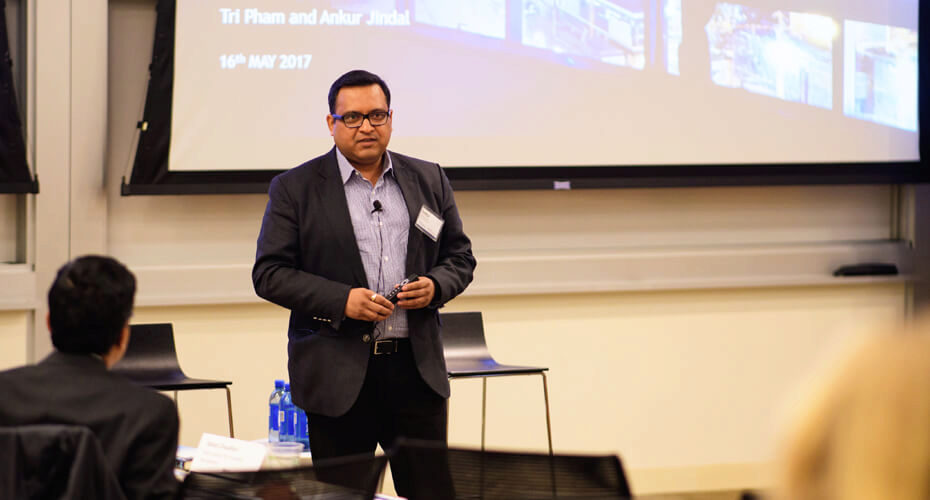
Tata Communications has been increasingly investing in emerging technologies, according to Jindal. Topping the list are software defined networks, mobile platforms and security technologies, followed closely by AI, automation, and analytics. Innovating in the Internet of Things (IoT) space is also a high priority.
To accelerate product development, Tata Communications uses a partnership-led approach with selective investments for strategic leverage. The firm forges relationships with venture capitalists, incubators, government bodies, and startups.
Tata Communications also sources ideas internally. “We’re looking at how we can crowdsource ideas from across the business. We have ten thousand people globally,” Jindal noted. He described a business incubator program called Shape the Future which has been responsible for internally crowdsourcing over 500 business ideas since it was created: “Through this process we can select the most promising ideas, an idea which can give us a significant top line in the next five to seven years.”
The internal innovation effort is paying off: a winning 2014 idea led to the launch of LORA, India’s first nationwide dedicated IoT network. This year the first customers were signed, and the project has received board approval to invest and scale up.
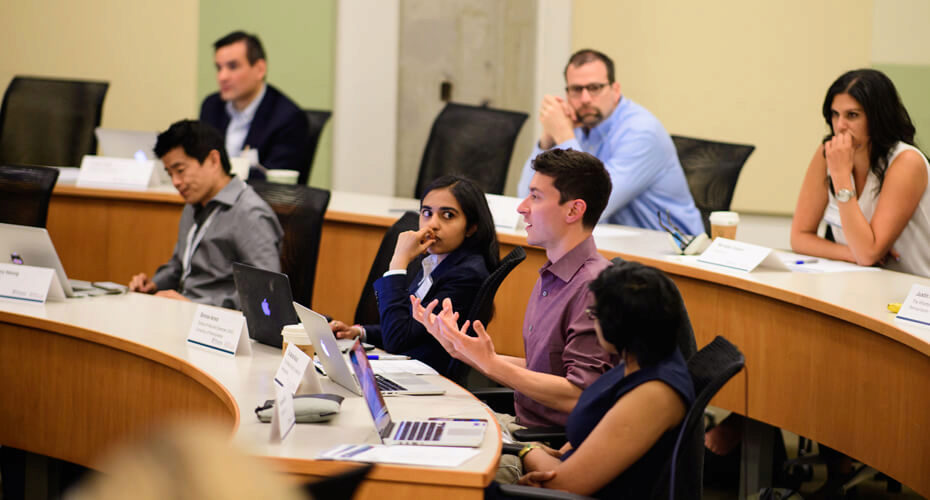
“Back in 2010 when we started the company, we had to explain what ‘Big Data’ meant in most of our conversations with enterprises,” said Ron Bodkin, evoking how speedily technology has been moving.
Bodkin is the vice president and general manager of artificial intelligence at Teradata, a provider of database-related products and services. Wharton’s Singh noted that Teradata has engaged in a lot of external growth and has been able to adapt dramatically in a rapidly changing environment.
A major focus for Teradata these days is enterprise artificial intelligence (AI) and deep learning, a technique that enables machines to solve problems more like the human brain does. “We feel this is a key, key, future direction for Teradata as a company.”
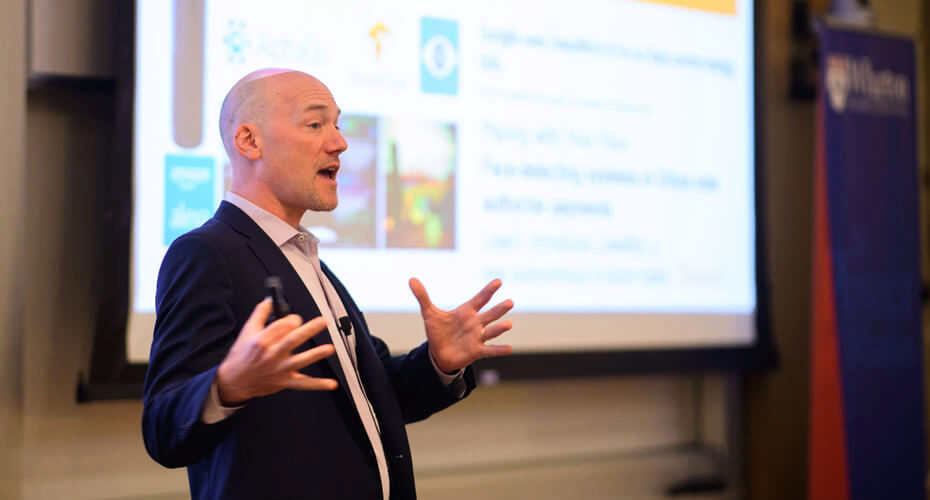
Bodkin commented that much of the activity in the AI space has only been around point solutions such as reducing fraud in banks and retail stores. But he predicts a “massive change… in the economy that’s going to result from using autonomous applications.” Point solutions will give way to business processes that are “AI-first.” As early as 2019, he said, we will see “a significant mandate for the C-suite: ‘we’ve got to get serious about this, this is disrupting us.’” And by 2021 AI will be widespread in most major industries.
Moreover, it won’t be enough, said Bodkin, to “simply be a buyer, a purchaser, without any kind of strategic relationship or deeper consideration.” Firms facing the AI challenge will need to develop connections and ecosystems in order to succeed.
How Established Corporations Innovate
How are large, long-established companies partnering with other firms to spark innovation? In the session “Building Ecosystems: Innovation Networks, Partnerships, and Investments,” speakers from Citibank and Comcast shared their experiences.
According to Niki Manby, the managing director and global head of innovation and strategic partnerships at Citi Ventures, new technologies are enabling cross-sector collaborations for the financial services industry: IoT, blockchain, smart contracts, AI, biometric authentication, and security innovations. “We’re on the precipice of change for how consumers engage and the data that will be available to us,” she said.
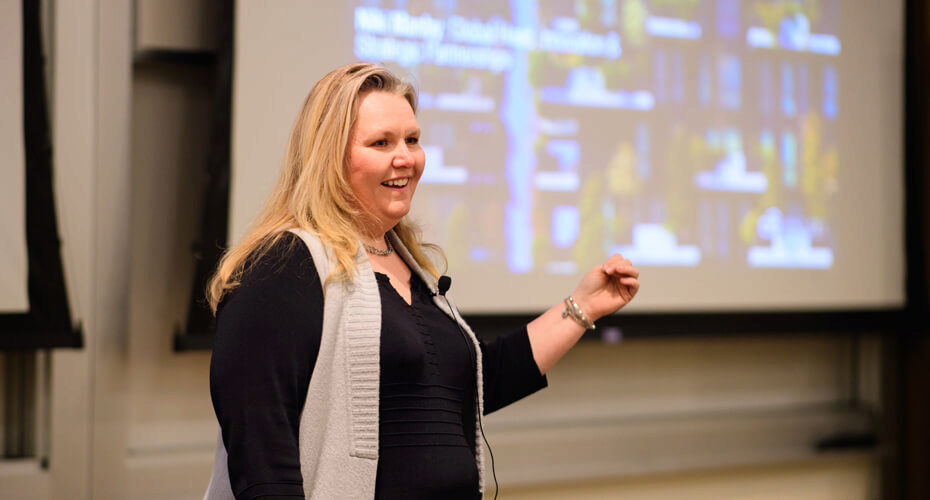
But Manby drew a distinction between partnering with startups and partnering with other large corporations. “We’ve got a lot of experience — because of our engagement on the investing side — with trying to bring startups into the ecosystem,” she said. “But bringing in other corporates… is an entirely different exercise.” She said it could be challenging for an organization “that has a very long history of doing things very well yourself.”
One promising development is Citi’s recent participation in Cisco’s CHILL project (Cisco Hyper-Innovation Living Lab). The attendee list featured heavy hitters: in addition to Cisco and Citi were GE, Intel, and DB Schenker. An unusual aspect of the process, said Manby, was “the seniority of the folks in the room: SVPs, directors, managing directors, P&L owners who have the ability to make a decision to go.” Moreover, all of the solutions pitched were ones that couldn’t be achieved with just one company’s assets.
Manby called the experience “a really fantastic demonstration of what we think is possible.”
Like Manby, Louis Toth helps drive innovation for a well-established firm: Comcast. As the managing director for Comcast Ventures he worked on external strategies. He recently joined Strategic Development to generate internal projects.
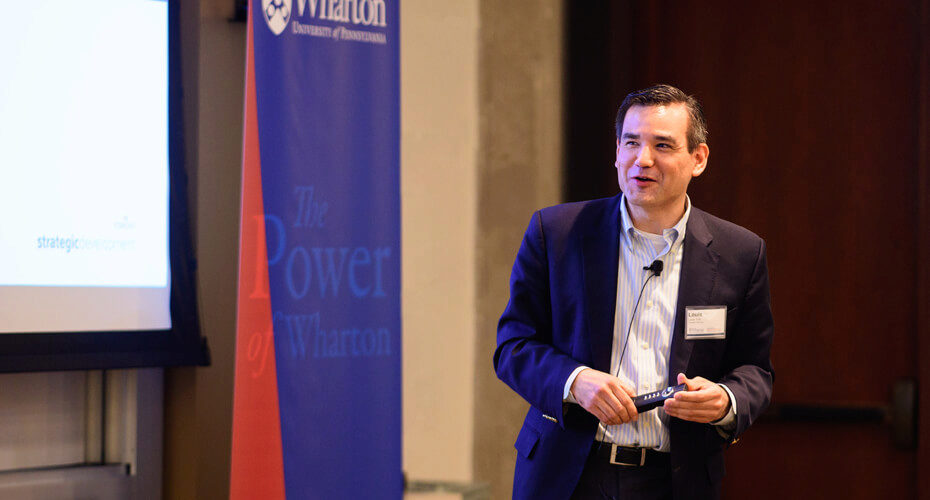
Toth characterizes the venture effort at Comcast as “fairly sizeable… We probably make about 20 new investments a year, and you’ll see a wide variety of different sectors.” The sectors include advertising, enterprise and business services, consumer, enterprise infrastructure, and business intelligence.
He said Comcast Ventures prides itself on operating on a venture time scale, and also on “really putting our money where our mouth is” when it comes to investing in startup companies. “We follow through with networking, making introductions, and provide insights about what it’s like to work with Comcast.”
On the Strategic Development side, Toth explained that he looks for white spaces in which he can leverage Comcast’s assets and infrastructure. He gave the example of Machine Q, a new Comcast business that provides enterprise IoT solutions such as industrial monitoring, tracking livestock, and utility meter reading. The project was announced last year and the pilot is moving forward.
Exploring Organic and Inorganic Strategies
“We’ve been pretty open about leveraging all forms of innovation, not just stuck in one mindset,” said Rama Naageswaran, a vice president for corporate strategy at Cisco. He presented Cisco’s five pillars of innovation: Build, Buy, Partner, Invest, and Co-Develop.
He spoke about some current market disruptors. One is hyper-connectivity: the acceleration of digitization, with 50 billion devices now in use worldwide. Another is the speed of innovation: the iPhone was invented in 2007, and by 2015 the mobile app economy had hit $100 billion.
According to Naageswaran, digitization and market shifts are leading to increased customer expectations and requirements. He also said that the traditional buyers’ universe for Cisco is expanding to include four different types of customers: the line of business/digital leader, CIO/IT buyer, OT (operations technology) buyer, and network/cloud operator. It was important, he said, for Cisco “to be very clear about defining the customer landscape.”
Naageswaran noted that the businesses he deals with are moving away from outsourcing and toward co-creating with large and small vendors. This theme was echoed throughout the conference. One way Cisco has been facilitating that process recently is by setting up Innovation Centers around the world including in Toronto, London, Berlin, Rio, and Sydney.
“To be relevant [in a] digital world, we need to be close to customers and be in an engagement that doesn’t look like a vendor and a buyer, but that we are co-innovating and co-creating,” he said.
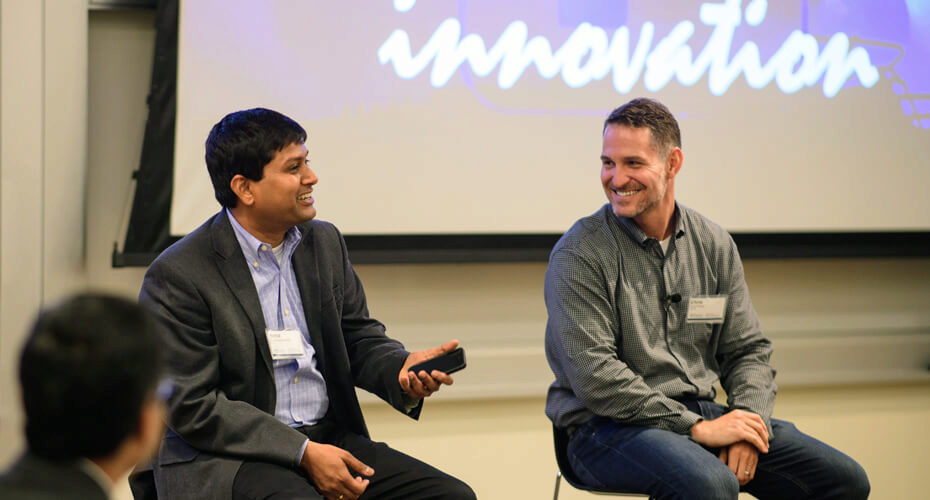
Pandora competes with three of the most powerful consumer tech companies in the world — Apple, Amazon, and Google — for music listening experiences, according to its chief product officer Chris Phillips. But the company is holding its own, finishing 2016 with a billion in advertising revenue and 200 million in subscriptions. How does Pandora distinguish itself in the music market?
The key is data science, said Phillips.
“Our ad revenue is powered by data. The insights we know about our listeners are key, and helps us differentiate how to advertise on Pandora and reach massive audiences in the U.S.” Data science also helps the company “manage our ad load by serving it smartly, and not degrading the listening experience.”
One recent innovation based on data is Thumbprint Radio, which takes listeners’ “thumbs” (thumbs-ups for songs) and weaves together one go-to super-station, said Phillips. He characterized the project as “wildly successful,” noting that it is used by 30 million people and has driven incremental hours that listeners spent on Pandora, thereby opening up more advertising inventory.
Looking to growing technologies such as voice-activated devices, Phillips noted how Pandora is excited about products like Amazon’s Echo, with an estimated 40 percent of listeners who own an Echo also using Pandora.
Phillips distinguished Pandora from what he calls the merely “good enough” competing services, saying, “Why are people choosing Pandora? It’s because with the fewest amount of inputs, you can get a quality music programming experience.”
Is Your Company Primed for Innovation and Collaboration?
A workshop was led by IDEO San Francisco, a firm that helps companies become more creative and enables them to “design” an innovation organization. IDEO leaders David Aycan and Maggie Howekamp gave participants a framework to think about what their organizations do well — and don’t do well — and the cultural and behavioral changes needed to move forward.
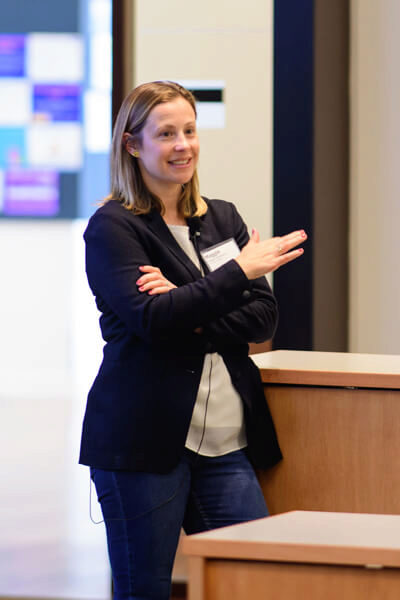
Aycan discussed the importance of proactively forging what he called a creatively competitive organization. The problem with waiting until you need innovative capabilities, he said, is that “those muscles to actually build new things, and nurture those new ventures and offers, are really hard to build up on short notice.”
Participants talked about experimentation in their companies, noting that it was critical for innovation but that most organizations needed to do more of it. A participant from a large pharmaceutical firm noted that firms can vary within themselves: his research team was great at experimentation and collaboration, while the commercial side struggled to innovate new services and solutions.
Closely related to experimentation was a fear of failure, many agreed. There needed to be a greater emphasis on learning from failed projects and moving on. Singh observed that small or owner-managed organizations may actually be more failure-tolerant, because in larger organizations employees become more concerned about protecting their image. Aycan agreed, saying that as a consultant he has observed this phenomenon.
The attendees also discussed keeping the customer in mind when introducing new technologies. In describing a financial services consulting project, one participant noted that you don’t just “get into fintech” but rather decide first how a new technology will impact your stakeholders and affect the user experience.
In closing the conference, Singh emphasized the importance of a portfolio approach balanced among different external and internal partnering strategies. He observed that data analytics seemed to be yielding next-generation business opportunities. He talked about developing partnering capability and culture, and about instituting repeatable processes around innovation.
Chaudhuri remarked on the commonalities he had seen across different sectors during the conference. Major technological change was of course a theme, sometimes related to products and services and sometimes more of an “enabler for the organization.”
He reinforced Singh’s point about instituting repeatable processes. “Empowerment doesn’t mean being un-structured… It isn’t about, ‘well, randomly do [innovative] things,’ or, ‘just have a bunch of smart people.’ It’s about striking that balance and giving structure where it’s needed.”
Podcast: Listen to Saikat Chaudhuri and Harbir Singh discuss these conference themes on Business Radio 111.



